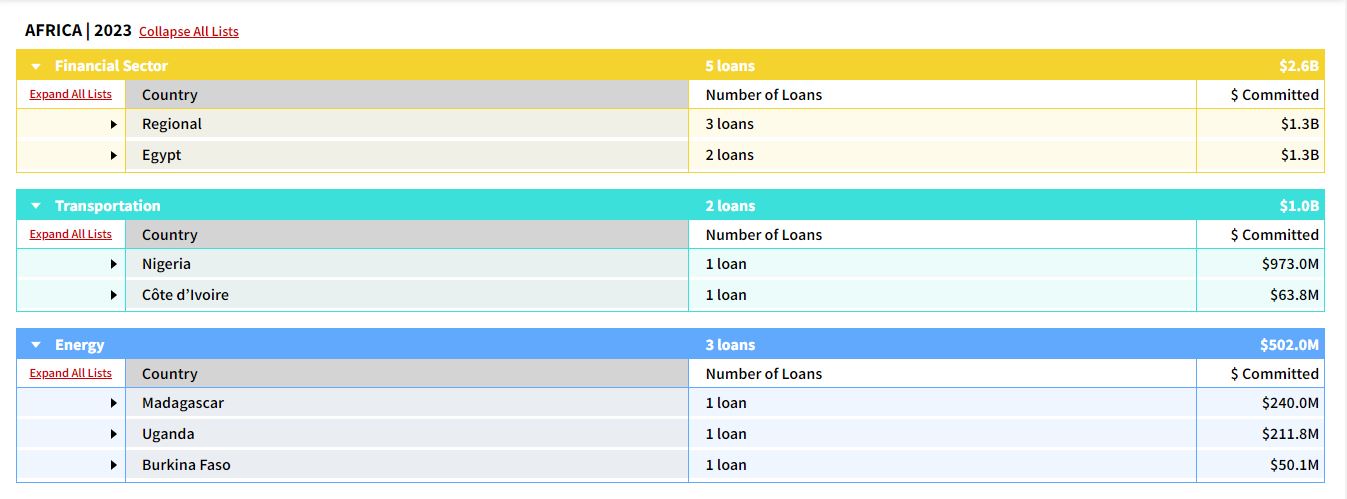- Africa received loans worth $4.6 billion from China last year, an increase from what economies across the continent received in 2022.
- This amount is, however, a far cry from Beijing’s massive infrastructure financing witnessed before the Covid-19 pandemic.
- Beijing will host African leaders for the Forum on China-Africa Cooperation between September 4th-6th.
A total of nine countries in Africa received Chinese loans worth $4.6 billion last year, an increase from what economies across the continent received in 2022. However, this amount is a far cry from Beijing’s massive infrastructure financing that was witnessed before the Covid-19 pandemic.
The new statistics from the Boston University Global Development Policy Centre come just days before Beijing hosts African leaders for the Forum on China-Africa Cooperation, scheduled for September 4th-6th.
In 2023, lenders from China processed approximately 13 loans targeting various projects across the continent with the biggest beneficiary being players in the financial services industry who received loans worth $2.6 billion.
Other sectors in Africa that received significant funding from Chinese institutions were state-owned investments in transport at $1 billion, energy at $502 million, Information Communication and Technology (ICT) at $396.5 million as well as a non-energy mining project in Eritrea that got $85.8 million in funding from Beijing.
China directs more loans through multilateral lenders
According to Boston analysts, over half of the monies from China to Africa were processed through multilateral lenders, a shift from an earlier trend where the funding went directly to governments.
For instance, in the financial services industry, the state-owned China Development Bank (CDB) channeled $400 million in loans to support Small and Micro Enterprises (SMEs) under a project run by multilateral lender Afreximbank. This financing means that it will go to beneficiaries spread across the continent as Afreximbank rolls out SME support initiatives.
Additionally, the report shows that the Export-Import Bank of China (CHEXIM) provided $600 million in credit to facilitate trade and financial partnerships under the PRC Support Initiative. To boost trade finance in Africa, CHEXIM further signed a loan of $300 billion with the Africa Finance Corporation (AFC) in 2023, too.
In the transport sector, Africa’s most populous country Nigeria was the biggest winner after securing a $973 million loan from the CDB for the construction of the country’s first standard gauge railway line. The 1,400km railway will traverse the states of Lagos, Oyo, Ogun, Kaduna, linking them to the West African country’s industrial hub of Kano. This funding will also extend the Kaduna-Kano railway section, which is approximately 200km.
Another big winner in Africa’s transport industry was Côte d’Ivoire, which secured $$63.8 million in credit from the Bank of China (BoC) for the construction of the 50km Tioroniaradougou–Dikodougou Road. This loan agreement also provided additional finance for rehabilitation and asphalting works in the West African country.
Madagascar, Uganda, and Burkina Faso secure financing in energy
In 2023, Chinese investments in the energy industry in Africa totaling $502 million went to three countries: Madagascar, Uganda, and Burkina Faso. In Madagascar, the CHEXIM disbursed $240 million to set up of the 64MW Ranomafana Hydropower Plant, in Ikopa River.
For Uganda, the third phase of electrification of industrial parks in Jinja, Njeru, Masese, Kasese, Ishaka areas, which will run for a combined 118.5km, received $211.8 million from CHEXIM in the year under review.
Furthermore, Burkina Faso received $50.1 million in loan from CHEXIM for the development of a 25MW Donsin solar power plant. With this green energy investment, Burkina Faso aims to ensure energy security at Donsin airport and step up the country’s energy production capacity from the current 714.4MW.
Currently, at 92MWp, Burkina Faso is the leading producer of solar energy in the region, leading neighbours Mauritania (84MWp), Ivory Coast (37MWp), and Mali (50MWp). The country’s Donsin solar power plant is estimated to take 15 months to build.
Data from the Boston University Global Development Policy Center shows that China’s CHEXIM was the sole financier of ICT projects, channeling $249 million to Angola’s National Broadband Project and a further $147.5 million to the fifth phase of Uganda’s national data transmission backbone infrastructure/ e-government infrastructure project.
Angola is currently building a 2,000-km land optical cable in Angola and a submarine line linking the enclave of Cabinda under its national broadband project which aims at upgrading the country’s telecommunications infrastructure.
Under the non-energy mining focus area, the data shows an alliance of CHEXIM and other lenders from China committed an $85.8 million loan to Eritrea’s Asmara Copper-Cold Polymetallic Project.

Read also: Kenya’s Debt Distress Threat to its Long-Term Development Agenda -Experts
Chinese loans in 2023 reflect a cautious stance from Beijing
Overall, China’s lending to Africa in 2023 saw a notable shift, reflecting a more cautious and strategic approach compared to the early years of the Belt and Road Initiative (BRI). Under President Xi Jinping, the BRI initially led to a surge in Chinese loans to Africa, with annual amounts exceeding $10 billion.
This aggressive lending strategy was part of China’s broader ambition to enhance global infrastructure connectivity. However, the advent of the COVID-19 pandemic and China’s subsequent economic slowdown resulted in a significant reduction in loans to the continent.
This decline was further exacerbated by the protracted debt restructuring processes in some African nations, raising concerns about the sustainability of such financial engagements.
Critics have long accused China of ensnaring African countries in so-called “debt traps,” where the enormous sums owed to Chinese companies allegedly place African governments under Beijing’s economic and political influence.
However, evidence suggests that both parties are engaged in a mutually beneficial partnership, with African countries leveraging Chinese loans for critical infrastructure development.
In a significant development, the lending patterns in 2023 marked a departure from the previous trends, with a more than three-fold increase in loans compared to 2022. This surge indicates China’s renewed interest in African markets, albeit with a more calculated approach.
According to a study by Boston University’s Global Development Policy Centre, China is now focusing on minimizing risks associated with highly indebted economies. The report suggests that Beijing is experimenting with a new lending strategy aimed at achieving a more sustainable equilibrium.










